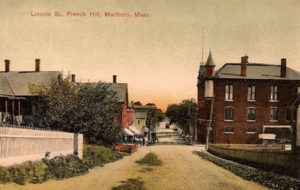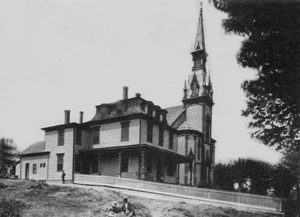By Brett Peruzzi, Contributing Writer

Marlborough – With a rich history dating back to the mid-nineteenth century, the dense neighborhood of French Hill in Marlborough, north of downtown and east of Lake Williams, has long been known as an enclave for generations of immigrants.
The shoe industry
The city was once considered the second largest manufacturer of shoes in the world. The hundreds of jobs at the shoe factories attracted many new residents from the French-Canadian provinces in the years following the Civil War, giving the area its name. They joined an earlier wave of Irish immigrants who had begun arriving by 1850, but somehow the name French Hill stuck as more French-speaking arrivals put down roots and became residents and eventually homeowners.
“Marlborough became a city because of the shoe industry,” affirmed Robert Kane, curator of the Marlborough Historical Society.
“French Hill grew by leaps and bounds due to all of the people who moved to town to be shoe workers.” The population growth, Kane noted, was one factor in the then-town changing its municipal charter to a city form of government in 1890.

French-Canadian immigrants make their mark
By 1890 French-Canadians made up the majority of both the owners and residents of French Hill. The heritage of its dominant group was recognized by two new streets being named Paris and Versailles. For French Hill residents, the neighborhood was a haven from the hostility as newcomers that they sometimes encountered elsewhere in the city.
“My father related that Mechanic Street was a ‘hard line’ beyond which the French and Irish crossed at their peril,” said Paul Brodeur, trustee emeritus of the Marlborough Historical Society.
The Italians flock to city
The demographics of the area began to shift again during the first few decades of the twentieth century. Some French Hill shoe workers and their families left Marlborough as a result of the shoe workers’ strike of 1899 in search of new jobs elsewhere. A significant number of immigrants from Italy began arriving to take their places in the factories. Kane noted that French Hill also had a famous frequent visitor for several years before World War I.
Baseball icon frequent visitor
“Babe Ruth lived in Sudbury, and he would come to the baseball field at Stevens Park and play pickup games with local kids,” he explained. “Of course, one of the other reasons he supposedly liked coming to French Hill is that he’d go to the bars after the game ended, and they stayed open until two or three in the morning.”
With multi nationalities, a new excitement
Amazingly, Brodeur noted, French Hill was a tight-knit ethnic enclave for French speakers for over a century.
“I attended St Mary’s grammar school in the 1960s, where my kindergarten teacher, a Sister of St. Anne’s, spoke very poor English,” he recalled. “Through the sixth grade I had a half a day of French and a half a day of English. There were a number of children who could not speak English when they began school.”
“While French Hill remained solidly French into the 1970s, it could not remain so forever,” said Brodeur. “As the post-war generation became better educated and increased in wealth, the multi-family, multi-story, limited acreage homes of French Hill became less attractive.”
Today, while the shoe industry is gone, a large number of Portuguese- and Spanish-speaking residents, many of them recent immigrants, add to the ethnic mosaic of French Hill.
And a new chapter for the neighborhood is now underway. The city received a $2 million MassWorks Infrastructure Program grant from the state last year for improvements along Lincoln Street.
“Many people are excited to see the momentum of the downtown revitalization that is taking place extend into the French Hill neighborhood as well,” said Meredith Harris, executive director of the Marlborough Economic Development Corporation.
Photos/courtesy Marlborough Historical Society
Click here for more Marlborough stories.











